- Introduction to the Metaverse
- Metaverse as the future of Internet
- Understanding the Metaverse through numbers
- Web2 vs Web3 approach to the Metaverse
- Current Metaverse Landscape
- Metaverse & its use cases
- Road ahead for Metaverses
- Closing thoughts
- References
Introduction to the Metaverse
In Oct 2021, Facebook changed its name to Meta Platforms and promised to invest $10 billion in its Reality Labs operation. In Jan 2022, Microsoft made a $69 billion bet with the acquisition of Activision Blizzard. Since then, Metaverse as a keyword on Google searches is used very often, often without having a proper understanding of the same.
Metaverse is the convergence of distinct technological trends to create the next version of the internet. At the core, metaverse sits at the intersection of 3 technological trends – massive virtual worlds, growing VR/AR market & the boom of Crypto and NFTs. Each of these sub sectors are huge in themselves. These technologies backing the creation of the Metaverse are not new, yet the revolution is in the convergence of step developments in these technologies.
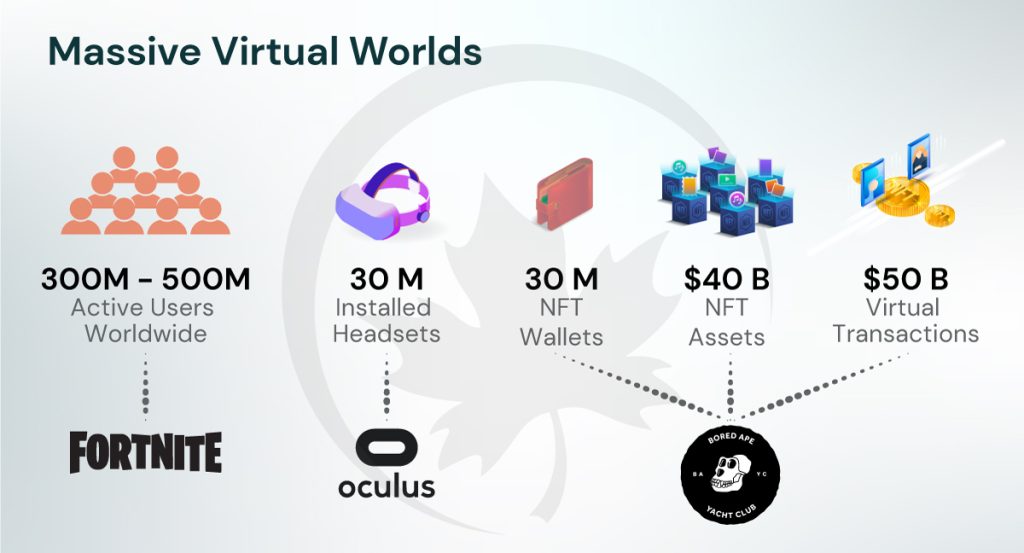
In Zuckerberg’s words,
You can think about the Metaverse as an embodied internet, where instead of just viewing content, you are in it. And you feel present with other people as if you were in other places, having different experiences that you couldn’t necessarily do on a 2D app or webpage, like dancing, for example, or different types of fitness.
How the metaverse has evolved
The metaverse is evolving from two decades of gaming and will be built upon gaming infrastructure
-
June 23, 2003Second Life is releasedMay 4, 2007Runescape reaches 1 million membersDecember 11, 2008Playstation Home is released on playstation 3October 7, 2010World of Warcraft reaches 12 million subscribersAugust 31, 2013Riot sells out League of Legends finals at Staples CenterAugust 25, 2014Amazon acquiries Twitch for $970 millionSeptember 15, 2014Microsoft acquires Minecraft for $2.5 billionDecember 27, 2018Fortnite nets Epic Games $3 billion in profit for the yearFebruary 20, 2020Decentraland is releasedMarch 11, 2021Roblox(RBLX) tops $39 billion in market cap in its IPOOctober 28, 2021Facebook changes company name to MetaDecember 4, 2021Virtual land adjacent t Snoop Dogg’s Sandbox estate sells for $450,000 in ETHJanuary 18, 2022Microsoft announces plans to acquire Activision Blizzard for $68.7 billion~55 MillionDaily active users on Roblox~250 MillionDaily trading volume of NFTs at peak~500 Millionmetaverse real estate sales+$10 Billioninvested by Meta into metaverse development annually~11 MillionXR headsets shipped, 80% produced by Meta
The timeline shows how the metaverse has come into being, how deeply it is connected with the evolution of gaming and showcases how these 3 different forces will come together to make the metaverse a reality.
Money flowing into the Metaverse
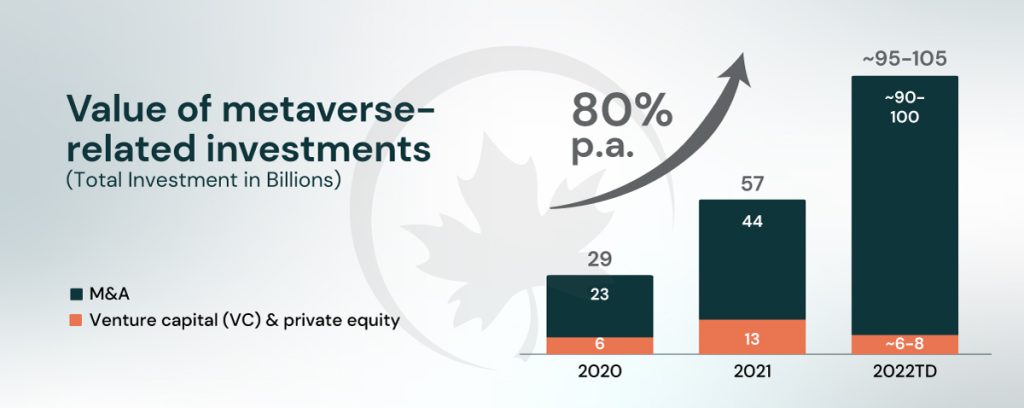
The scale of money flowing into metaverse-related investments is massive; already $120 billion worth of investments have been made across VC & PE, M&A and corporate investment. However, the current rise & scale in investments is majorly driven by acquisitions from big technology corporations like Microsoft.
Metaverse as the future of Internet
Going back to the dot-com boom, it’s easy to forget that the internet was a place for geeks who had no real friends to talk to, and would hangout in front of a computer all day, probably trying to make friends. But from the ashes of this bust, rose a $5 trillion dollar e-commerce market. And, every big business today – Amazon, Apple, Microsoft, Meta etc was born from those ashes only. If anyone had predicted that this is how things would turn out, people would have literally called him mad. Nothing else.
The current bust of the crypto boom is very similar. The similarity is striking and yet we still under acknowledge the huge wave that’s just on the horizon. If put broadly, the metaverse encompasses literally everything that will be built in the future. It really is the next upgrade to the internet. Once the metaverse happens, the internet will look like the telephone revolution to us.
Metaverse in the next upgrade to the internet that will seamlessly bridge the gap between the virtual and the physical worlds. All major social interactions, communication, consumer interactions, work environments & business experiences will become intertwined bridging the virtual and real worlds completely. This revolution is not somewhere far off in the future, it’s very much here already.
Gaming is one such industry, where all of the interactions already happen on a daily basis, though only 2D and keep users engaged with record play times. Apart from gaming, we are already seeing millions of users gathering at virtual 3D concerts, shopping in virtual malls with crypto currencies, huge NFT art galleries with thousands of users and owning customizable virtual homes. Some examples for these are the virtual concert with Ariana Grande on Fortnite, and DJ David Guetta playing on Roblox. Even imagining these were impossible just a couple of years ago.
The top activities consumers are excited about to interact in the metaverse are Social, Entertainment, Gaming, Travel & Shopping. There are already a lot of startups providing a lot of value here. The top use cases businesses are implementing are marketing initiatives, learning & development for employees, meetings in the metaverse, events & conferences, product design and digital twining.
Saying metaverse as the future of the internet, doesn’t really do justice to envision what exactly it really is. So, instead of defining it as to what it is – let us try to understand by disregarding a lot of notions about it by seeing what it definitely is not.

The metaverse is NOT a replacement for real life
The metaverse will not be about a choice between a virtual self and a real self, but it’ll be about complementing and supplementing our real world experiences with real life experiences. A good analogy for this is, just like we use and have a real presence on Instagram, Email etc and we also meet real friends and have fun together. The metaverse will be a very close union of the digital & the real world, with a digital extension for everything that’s real.

The metaverse is NOT many different worlds
Considering the metaverse to be many different worlds is similar to saying that we have many different internets today. The metaverse is the envisioned end state—incorporating all digital worlds alongside the physical world, with interoperability between them all. Today, metaverse users are spread across multiple platforms; for example, Decentraland, Fortnite, Minecraft, Roblox, and The Sandbox. Each world is not interoperable with any other world.

The metaverse is NOT just VR/AR
VR/AR are great interfaces to access the metaverse, but they’re not the only way to access the metaverse now or in the future. If the metaverse is like the internet, VR/AR devices are like the first versions of the desktop computer.

The metaverse is NOT just gaming
While the metaverse will definitely be built on top of the gaming infrastructure rails we have already built. And also gaming is the seed for the growth of the metaverse. But, the metaverse will not be limited to only gaming. We can already see these evolving use cases such as virtual concerts being held on FortNite, brand collaborations to feature in Zepeto etc.

The metaverse is NOT Web3
Web3 definitely drives and is necessary to the development of the metaverse, as they enable core features such as ownership & interoperability. While Web3 is all about the next leap in technology capability with decentralization as a core feature, the metaverse can be both centralized and decentralized. It’s more concerned with providing the consumers with more immersive & intertwined digital experiences.
Understanding the Metaverse through numbers
By 2030, the value of the metaverse could be anywhere between $5 trillion to $9 trillion. In 2022 till now, investment into the metaverse space has already more than doubled than that of entire 2021 – it has reached more than $120 billion already. Andreessen Horowitz – one the leading VCs funds in Crypto space launched Games Fund One, releasing $600 million in venture capital to invest in game studios, metaverse infrastructure, and games.
Fundraising in the Crypto & Metaverse space has seen a huge explosion in the recent years.
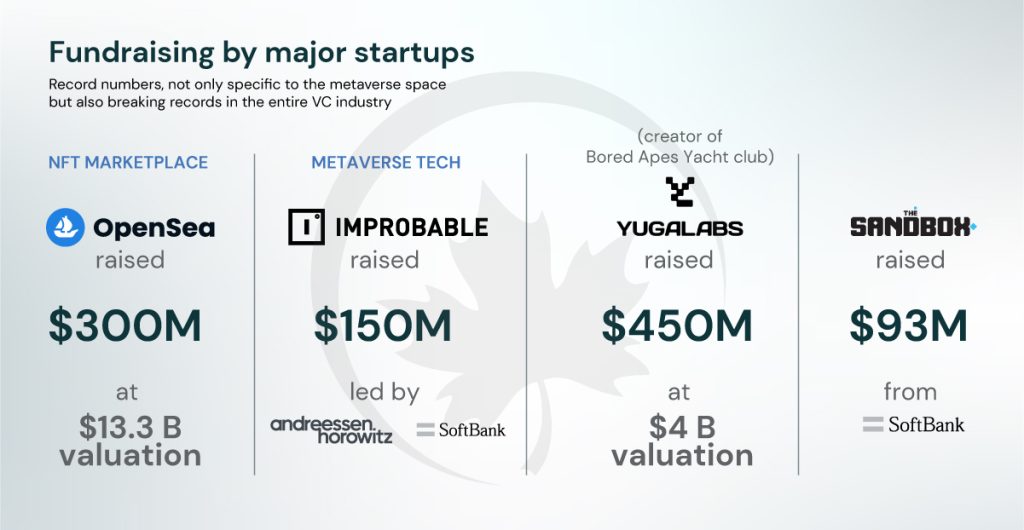
Major mobile gaming worlds are already seeing huge numbers of users and high transacted value just within the game alone. Fortnite has more than 20 million daily active users (DAUs), generating more than $14 billion in transactions between 2018 and 2020. Zepeto—Asia’s largest metaverse platform—has over 300 million global users. Roblox, leading mobile gaming world boasts almost 50 million daily active users (DAUs) while it’s still heavily concentrated mostly in the US targeting 9-15 yr olds only. These are entirely different metaverses and are not interoperable, a user of one world mostly sticks with the same world alone due to the strong network effects. The massive scale that can be achieved for a globally integrated metaverse is just mind-boggling.

The above infographic captures all the major metaverses and shows how successful they are in ensuring immersive user experiences across demographics, geographies and devices. This shows the immense potential of metaverses to engage everyone.
According to research from ARtillery Intelligence, 800 million users actively use mobile AR, a number that it projects will grow to 1.7 billion in 2025. More than half of the 6 billion smartphones in use today are sufficiently powerful to enable mobile AR.
According to Meta’s Zuckerberg speaking about Oculus VR headsets in 2020 says,
If we get to 10 million units active, then that’s kind of a critical magic number. At that point, you have a self-sustaining ecosystem.
Meta shipped 10 million plus Oculus Quest 2 headsets in 2021.
After reaching the critical mass with regards to active VR headsets & Apple’s expected VR headset launch in 2023, the growth is expected to accelerate further and is expected to reach 88 million units by 2025.
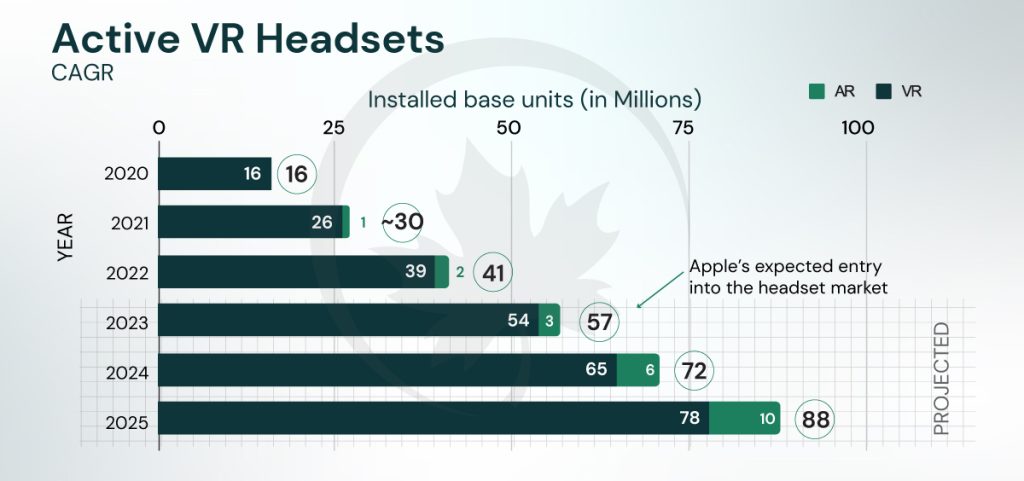
According to BCG, the total metaverse market is expected to be worth between $250 billion to $400 billion by 2025. Majority of the value is generated from the virtual asset economy – NFTs, cryptocurrencies and smart contracts. We can already see substantial developments in these areas with major investments & brands making their presence felt in the metaverse already.
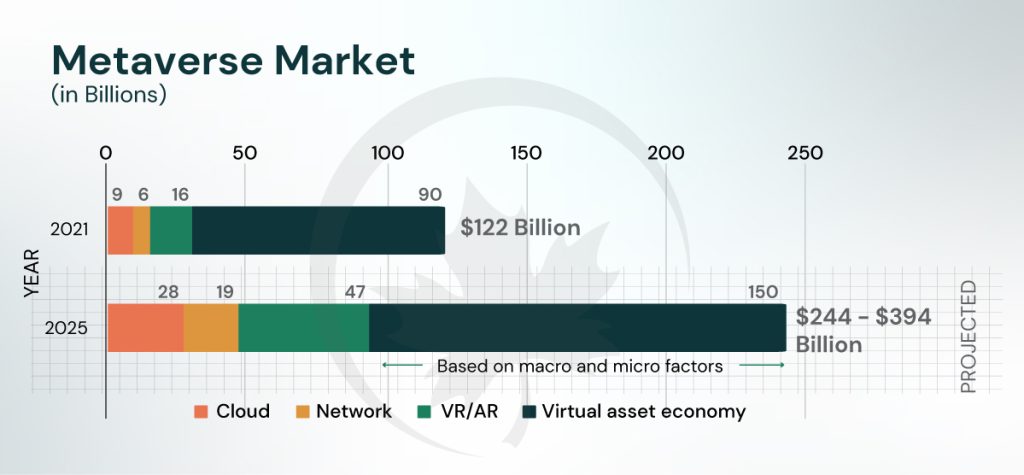
Venture capitalist Matthew Ball estimates that more than $50 billion in virtual goods were purchased in 2021 using “traditional” payment modes. There are some 30 million NFT wallets, including 1 million active wallets, which spent some $40 billion on NFT purchases in 2021. A JPG file by digital artist Mike Winkelmann, known as Beeple, for almost $70 million in March 2021. Sotheby’s first NFT auction in April 2021, brought in nearly 3,000 new buyers and generated more than $17 million in sales. Louis Vuitton has launched Louis the Game, which integrates some 30 NFTs. The list doesn’t end here, and major brands such as Gucci, Burberry, Adidas, Nike, Prada, McDonald’s, Salesforce, US National Football League etc.
At the end of 2021, a total of approximately $90 billion in virtual and physical money was circulating on m-worlds and is growing rapidly, cementing the arrival of the metaverse already.
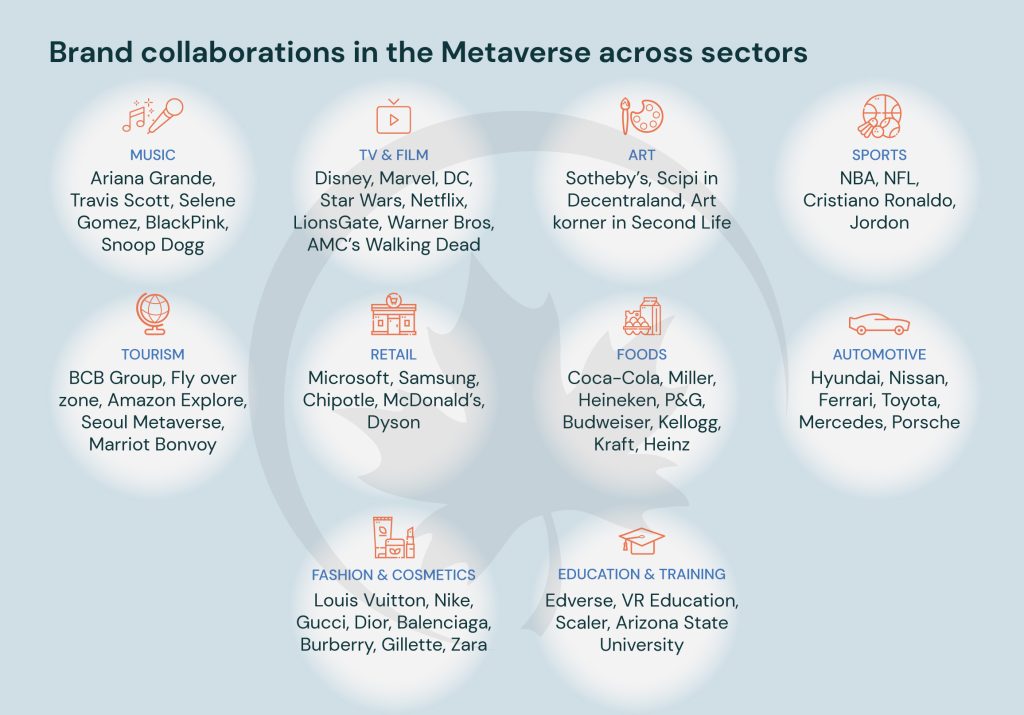
The metaverses built on the Web3 infrastructure are themselves huge with big market caps. Each of these worlds are powered by their respective token minted on the blockchain. However, this massively underestimates the potential of the metaverse as major m-worlds such as FortNite, Roblox, Minecraft etc are currently built on Web2 only.
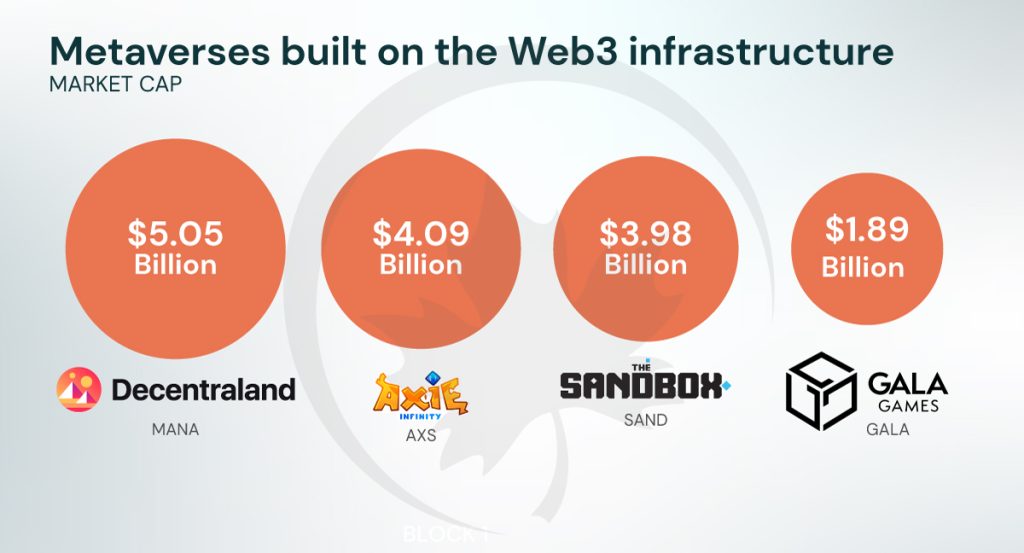
The integration of massive virtual worlds currently on Web2 onto Web3 infrastructure, is something we still have to wait and watch. Technically, however it is not a challenge to imprint the entire metaverse with all its assets & economy onto the blockchain. But, doing this in the current state of blockchain computing power & speed will sevelry limit the capabilities of the metaverse to run seamlessly. This is the primary reason that limits the transition of massive worlds onto Web3 as of today.
Web2 vs Web3 approach to the Metaverse
There are various characteristics that are central to the functioning of the Metaverse and can be categorized and understood as follows,
- Platform characteristics
These are the underlying characteristics that make the whole end-to-end immersive experience of the metaverse possible.- Organizational structure
This is central to the categorization of a Metaverse as a Web2 or Web3 powered one. Web3 strives to achieve and ensures decentralization in everything done. - Data storage
This refers to the storage of the various assets and currency circulated within the metaverse. Currently, Meta stores all the assets related to every consumer in their centralized servers. - Platform format
This refers to the kind of devices supported by the metaverse, and what kind of experience most of its users prefer and engage mostly. - Payments infrastructure
The preferred mode of payment widely used among the residents of the metaverse.
- Organizational structure
- User interaction
- Digital assets ownership
This refers to the method of digital assets ownership on the platform. - Digital assets portability
Portability of the digital assets is concerned with the interoperability of these assets across platforms, as their existence doesn’t depend on the platform at all. - Content creators
The content within the platform can either be generated by the platform or by the users of the platform itself – creating a self contained ecosystem. - Activities
Various activities that can be done within the platform for consumer engagement. - Identity
This is concerned with the existence of an identity for the consumer within the platform.
- Digital assets ownership
- Commercials
- Payments
The mode of payment used within the platform in reference to various transactions performed. - Content revenues
The revenue generated from the content within the platform goes to multiple parties responsible.
- Payments
Comparing Web2 and Web3 metaverses on these different parameters will help us compare and understand the key differences and unique value propositions offered by Web3 technology which Web2 can’t replicate.
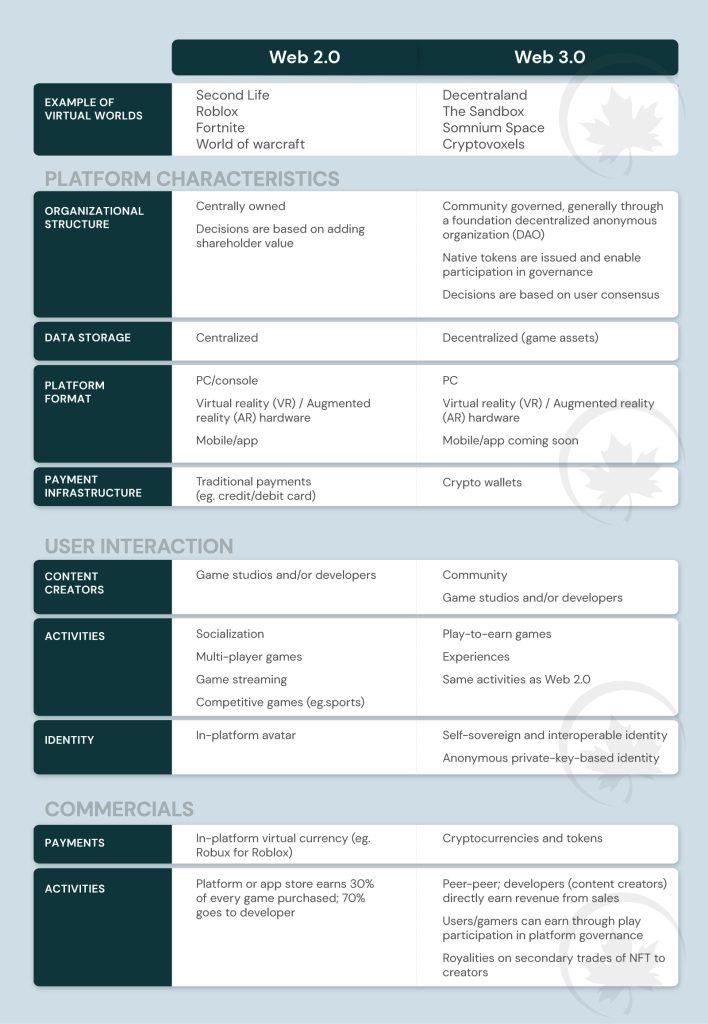
Understanding consumer behavior and psychology becomes key to the progress and development of the metaverse. This helps in aligning the overall business with customer needs and requirements. And will also help Startups & Venture Capital to develop market leading products and fund ventures which fulfill the market needs totally.
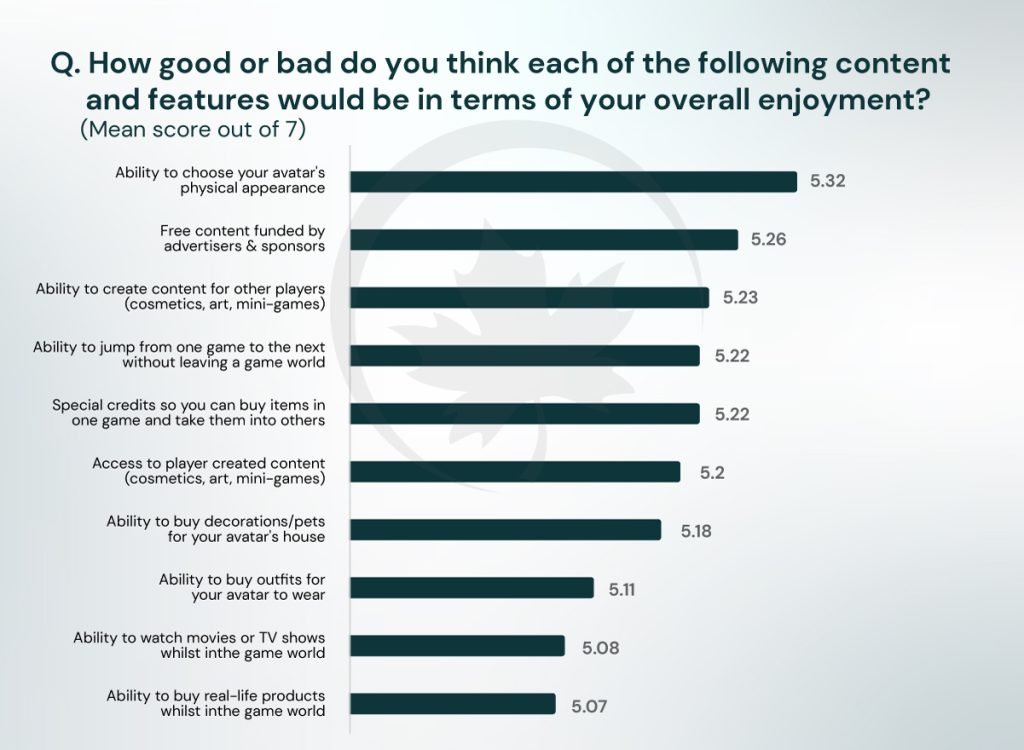
There are various insights one can derive from the above infographic.
Avatars are very important and central to the entire experience within the world. This is expected and can also be seen in comparison with the importance we place on our bodies in the real world. Another major theme, we can observe across the answers is the importance of interoperability between different games and platforms demanded by the consumers ensuring a seamless experience for everyone. We also see that consumers of metaverses engage very strongly with branded experiences and sponsored content as well. This is strikingly different from the aversion seen for sponsored and branded content on Web2 platforms.
Current Metaverse Landscape
All the major Web3 metaverses are shown below.
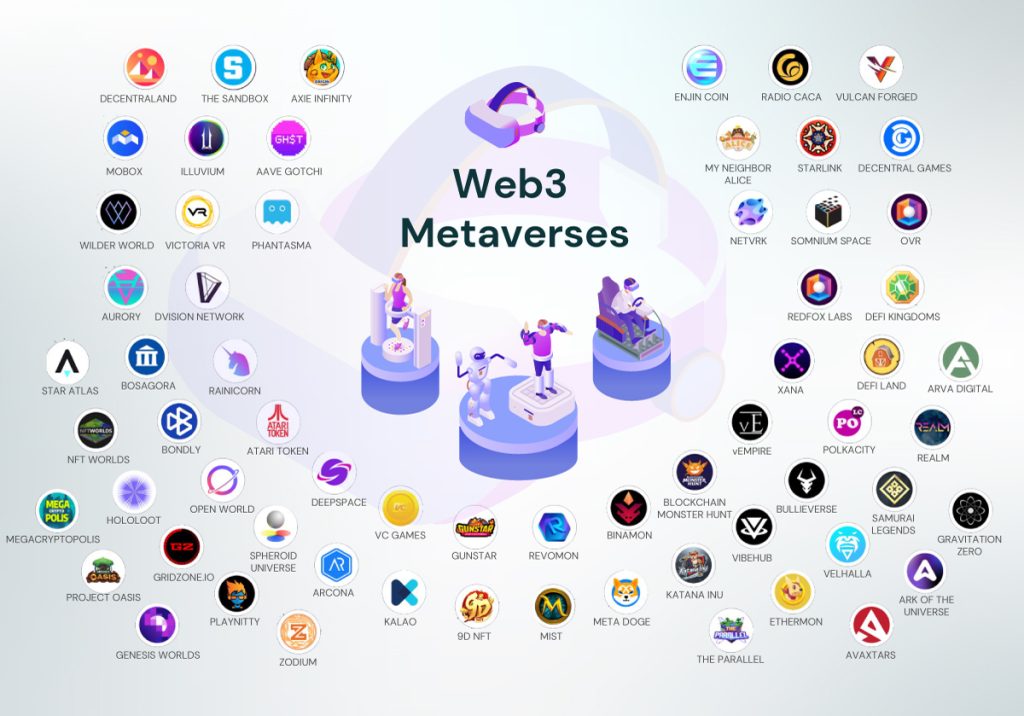
A detailed comparison of all the major Web2 & Web3 metaverses can be seen below.
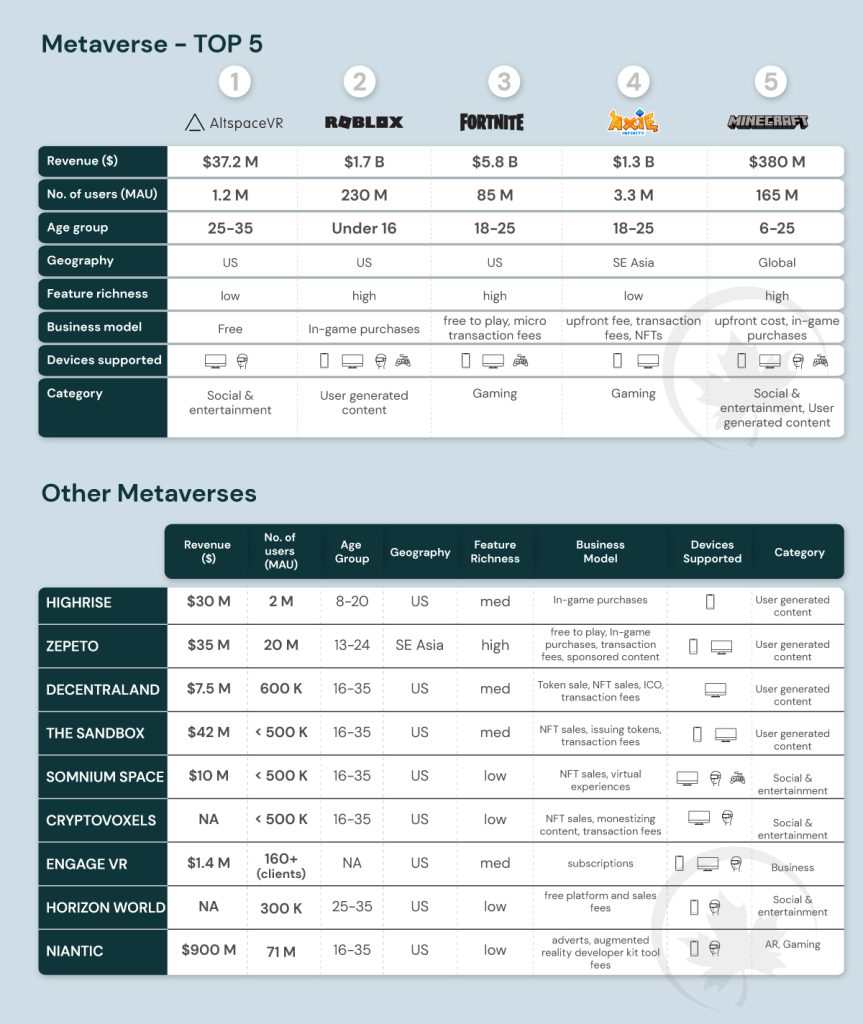
This shows us that there are already major players in the metaverse space with many having more than a million monthly active users (MAUs). It is crazy how huge the metaverse space has become in a couple of years already. But many of the players in the metaverse space are either huge corporations or gaming firms focused on teenagers.
Some major takeaways by comparing these major metaverses are,
- Different consumer preferences and behaviors are observed across the globe, making it possible for multiple of these metaverses to exist simultaneously.
- All age-groups are already habituated to the world of experiences inside the metaverse.
- There’s also considerable revenue being already generated from these metaverse via in-app purchases and major brand collaborations.
- Different business models ranging from in-game purchases, subscriptions to NFT sales can be seen across different metaverses.
The table below lists all the major announcements in 2021 across 3 major metaverses – Roblox, FortNite, Minecraft. The diversity across the artists & brands further confirms the hypothesis about the pervasiveness of metaverse across different categories ranging from Entertainment to Fashion. Metaverse can be seen as the next version of social media which will become the primary mode of communication for everyone in the future. Similar to how FB, WhatsApp & Instagram are the primary way to connect with anyone today.
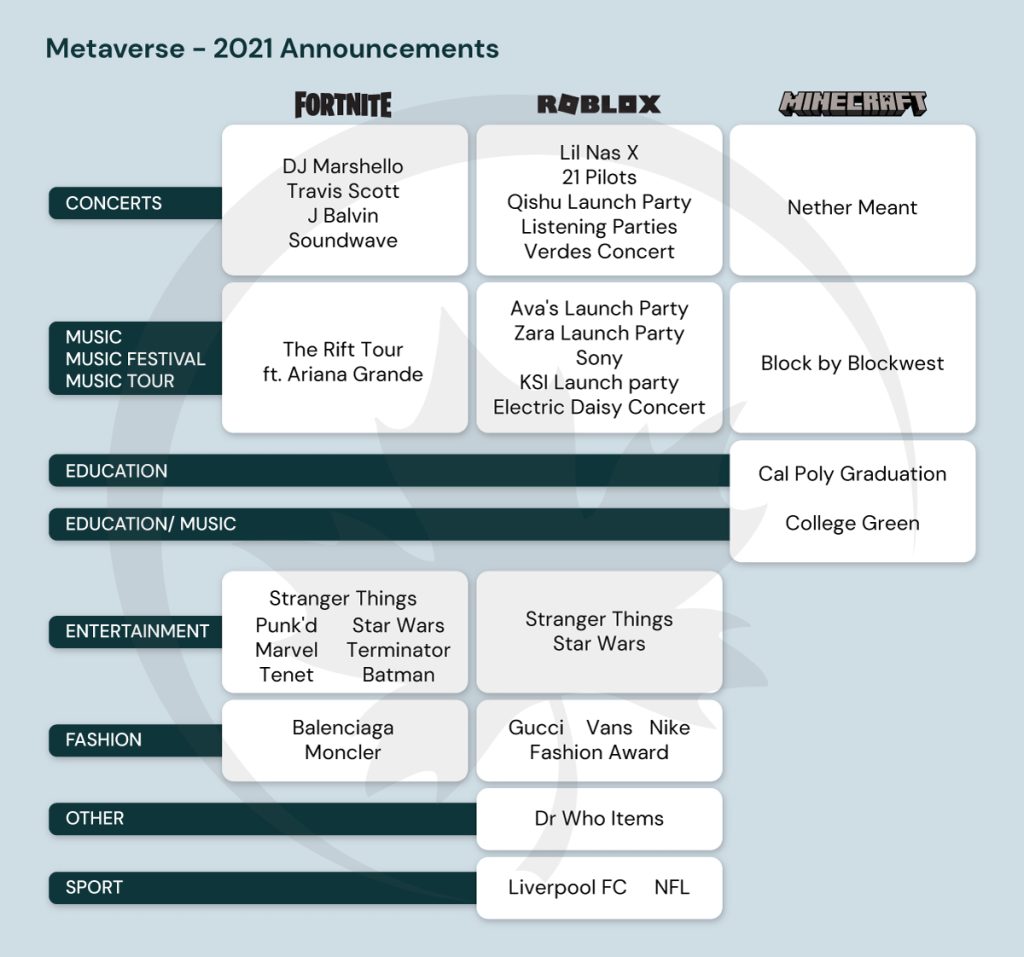
Metaverse & its use cases
A lot of example use cases can already be witnessed across sectors and brands on different metaverses.
Below are listed some interesting use cases along with an example,
- Product marketing: Coca-Cola auctioned NFT collectibles for International Friendship Day
- Customer engagement: Gucci launched its Gucci Garden on Roblox.
- Next-generation commerce: AnamXR uses game-engine technology to create cloud-based, virtual e-commerce platforms for 3-D immersive shopping experiences
- Brand loyalty: Adidas’ Bored Ape Yacht Club NFT release provided access to physical streetwear drops
- Education: Invact Metaversity uses a virtual campus for real-time lectures, breakout spaces, and outdoor areas
- Digital twins: BMW is experimenting with creating digital twins using Nvidia’s Omniverse technology
- Virtual tourism: Ariva Digital’s Wonderland platform is working to allow users to travel to imagined or recreated destinations
An exhaustive list of use cases have been compiled together spanning across different industries and across the chain of value creation. With the Metaverse, imagination is the only barrier to design an user experience for any Brand.
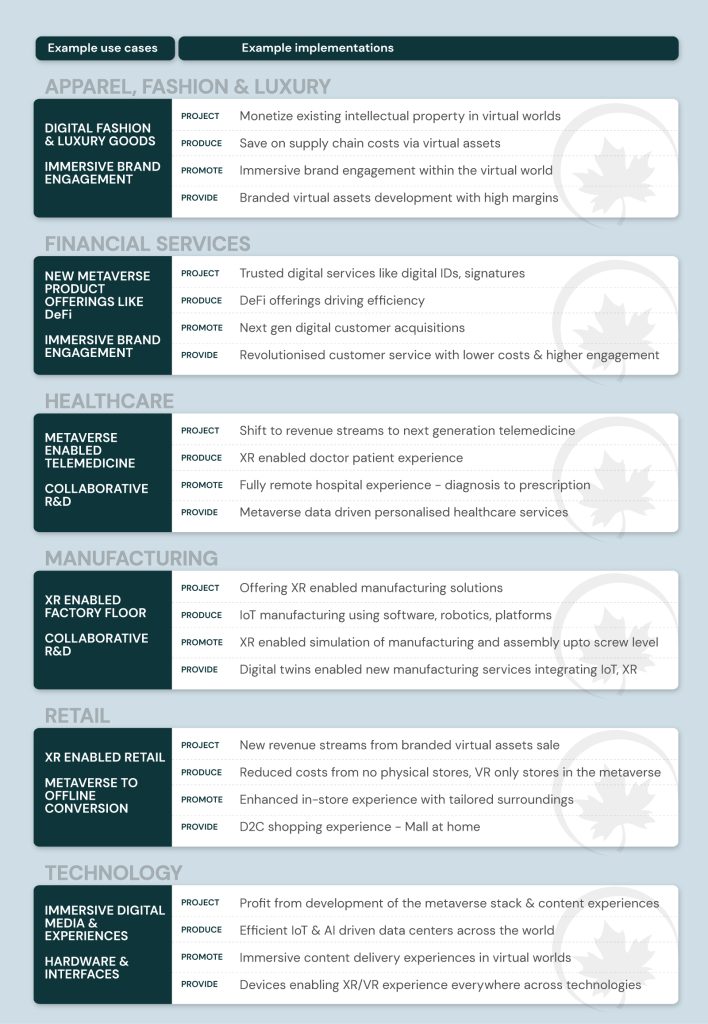
Road ahead for Metaverses
The metaverse is all about maximizing the human experience within the digital world. In the end, it’s all about augmenting and elevating the human experience. A great example and learning source will be the massive development of the mobile experiences over the past 15 years. The internet when it started was just a set of static websites to find important information, to the current state of being capable of hosting massive multiplayer games online. To maximize the benefits and the opportunities possible in the metaverse space, brands, companies and startups need to design great engaging experiences for consumers, end-users and citizens.
To quote Salesforce’s global innovation evangelist Brian Solis.
What the metaverse is really all about is community. The value of belonging to this community. The role you can play as a user in this community so that you feel like a stakeholder and not as a ‘user’.
However, focusing solely on maximizing the human experience may not be the best approach as there are broader implications to keep in mind when designing the future of the internet. There are clear societal implications that can’t be ignored with the development of the metaverse. Earlier cybersecurity was all about ensuring safe servers, nodes and networks. But in the metaverse, the screens have been extended into our real-world surroundings spreading the attack surface into our eyes, human brain and our living spaces itself. Relying on the goodwill of those participating in the metaverse may not be enough: social media, for example, has become one of the most influential forces of our time, for good and ill. And, all major tech companies today are feeling the heat from their Governments regarding the same. Metaverses will only exaggerate what we have seen happen in the case of social media.
One such example of the metaverse VR headsets capability of collecting data with its ability to track eye-movement can lead to major implications related to data privacy and many more. There are many facets of data that will be collected from these headsets such as eye opening and closure, eye movement, eye status, pupil properties, iris characteristics, facial attributes and many more. Using advanced technologies, the possible inference of personal characteristics may range from personality traits assessment, mental health, skills and abilities, level of sleepiness, Cognitive processes, Drug consumption, Age, Biometric identity, Cultural background, Physical health, Geographical origin, Gender, Mental workload.
It is very important for the organizations to build products very responsibly to generate value in the long run away from regulatory watchdogs. Metaverse will cause societal changes like never before, and guidelines and regulations will come in place later on.
A brief overview of the various players involved in shaping one of the key segments of the Metaverse i.e, Digital Identity.
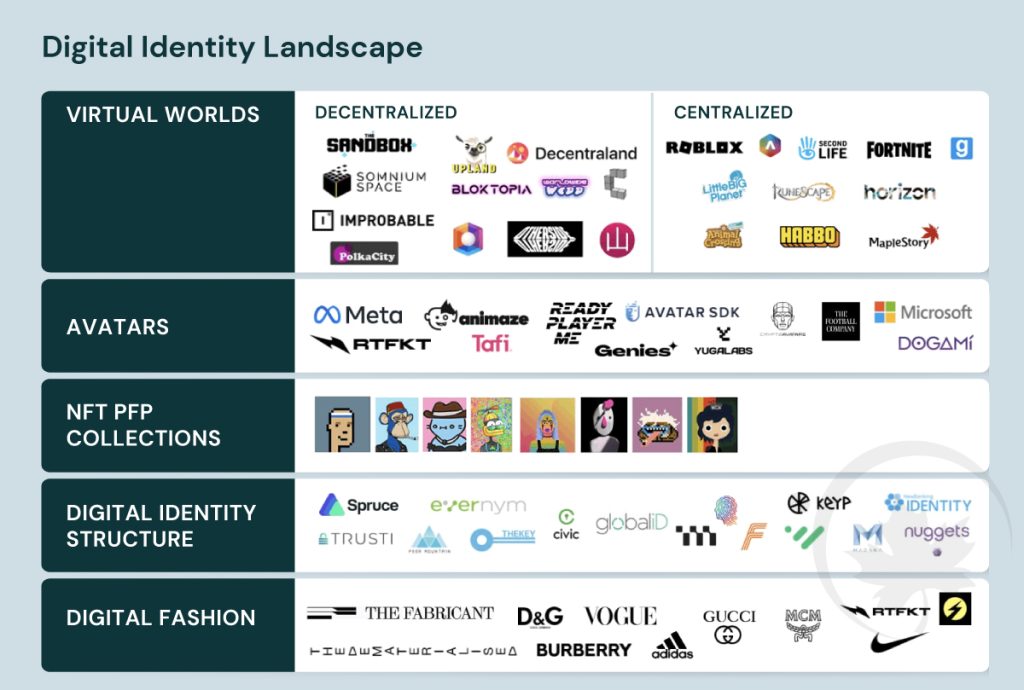
Closing thoughts
Consumers are already looking for ways to deepen themselves into the metaverse and bring it into their everyday activities seamlessly. And businesses are following suit with exploring new strategies to engage themselves in meaningful ways with the consumer in the metaverse. Within a decade, metaverse has the potential to change the world as we know it today – similar to how the internet changed everything we do within a decade.
McKinsey expects that by 2030, it is entirely plausible that more than 50 percent of live events could be held in the metaverse. More than 80 percent of commerce could be impacted by something consumers do there, from discovering brands to visiting a virtual store. Most learning and development could happen in a metaverse environment, as could most virtual or hybrid collaboration. This is huge. It is estimated that by 2030, an average internet user will spend up to 6 hours a day in metaverse experiences.
Finally, the metaverse has a potential to generate about $5 trillion in value by 2030. This is too huge to be ignored by any business, startup, consumer or government. It will have a major impact in everything we do today, our personal and commercial lives. No business, startup, VC firm or policymakers can ignore the tectonic shift we are in the middle of the next technology cycle. It will destroy many old businesses that’ll fail to adapt and create many many more new businesses.
References
- Web5 – The Decentralized Platform
- Unity – Bringing B2B Marketing into the Metaverse
- Standard Chartered – Enter the Metaverse
- Simpler Change – Understanding the Metaverse
- McKinsey – Value creation in the Metaverse
- JP Morgan – Opportunities in the metaverse
- HSBC – The Metaverse Multiverse
- Greyscale Research – The Metaverse
- Goldman Sachs – Framing the Future of Web 3.0 – Metaverse edition
- Deloitte – The Metaverse Overview Vision Technology Tactics
- Credit Suisse – Metaverse A Guide to Next Gen Internet
- Cointelegraph Research – GameFi Can Blockchain-based Gaming Redefine the Industry
- BCG – Corporate Hitchhiker’s Guide to Metaverse
- Accenture – Meet me in the Metaverse
- Chain Debrief – Into the Metaverse
